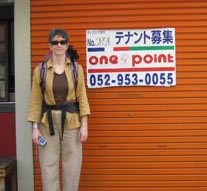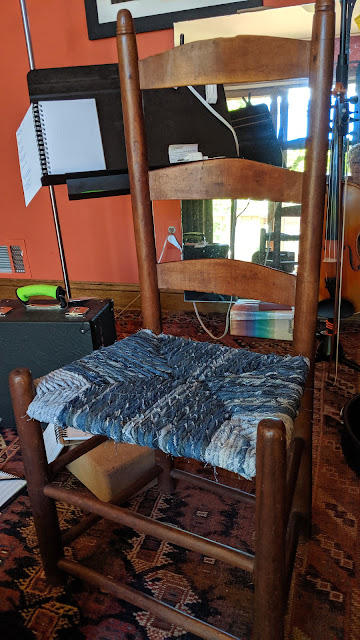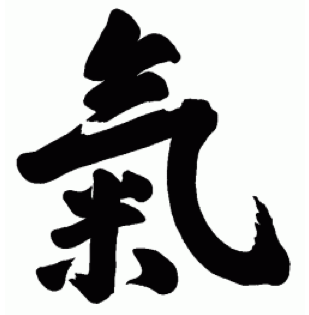Keep One Point
I've been slowly but surely writing of a series posts devoted to each of the four basic principles of Kokikai Aikido. One of these is Keep One Point to Develop Calmness.
We spend about 90 minutes in each aikido class, and most students practice once or twice a week - only a small proportion of the of hours we are awake each week. It may be plenty of time to spend doing a demanding physical exercise, but we need to spend more time working on the underlying principles for them to become second nature in our bodies. Fortunately, all of the basic principles are easily practiced at any time, not just in class. We can easily practice finding and keeping One Point while off the mat, and test the results when we're back on the mat.
What Is One Point?
One Point is a concept closely related to your center of balance. Centuries ago martial artists discovered that if the mind is focused on keeping this point low, one becomes stronger and harder to move. In Kokikai, we first learn to feel the difference between focusing this way and not doing so. Then we can work on trying to keep this focus, first while standing, then while moving and throwing.
Finding One Point
Stand comfortably in a natural posture that allows you to breathe openly - chin level, back straight but not rigid, shoulders relaxed. Imagine a point about two inches below your navel and within your abdomen, close to your spine. See if you can maintain your focus on this spot.
Practicing One Point
You can practice finding and keeping One Point just about anywhere: waiting for a doctor's appointment, when you're on hold, while you're walking the dog - in fact, just about any of those times you'd normally pull out your phone and start texting or tweeting! If you lose focus, just bring your mind back to your One Point. With practice, and patience, you will be able to find One Point more quickly, and maintain it for longer.
Why Keep One Point?
I'm a big believer in subjective research. Test the benefits for yourself! Once you know how to find One Point, you will experience the difference in your aikido practice. Then you can practice making sure you keep it at all times during your technique, looking for brief "openings" where you lose One Point.
But why not see if keeping One Point works in other situations, too? Do you ever find yourself thinking unkind thoughts or physically tensing up, maybe while driving, or shopping, or interacting with people you know? Try finding One Point and see if it makes a difference.
More Advanced Practice
Once you can find One Point easily, and keep it while moving, walking, and even talking, you may want to try a One Point meditation. You can do this sitting or standing. Decide on a length of time for this practice before you start - it can be one, two, five, ten or more minutes - it's up to you, but maybe just start with a couple of minutes. Find your One Point, and note what size it is in your mind. Now imagine it half that size. Then half again. Keep making your One Point smaller until it is infinitely small. Keep your focus the best you can until the time is up.
Alternately, do the same meditation, but when you have found your One Point, imagine it getting larger and larger, until it expands to fill the universe. Again, let your focus rest on this image. If your mind wanders, just gently bring it back.
One More Thing
I had to laugh when I first started taking piano lessons again as an adult. In one of my first lessons, my teacher told me to focus on an area below my navel, in the center of my body...It seems it's not only martial artists who have discovered the benefits of keeping One Point!
More Posts on the Four Basic Principles
Keep One Point to Develop Calmness
Relax Progressively
Correct Posture in Everything (forthcoming)
Develop Your Positive Mind
We spend about 90 minutes in each aikido class, and most students practice once or twice a week - only a small proportion of the of hours we are awake each week. It may be plenty of time to spend doing a demanding physical exercise, but we need to spend more time working on the underlying principles for them to become second nature in our bodies. Fortunately, all of the basic principles are easily practiced at any time, not just in class. We can easily practice finding and keeping One Point while off the mat, and test the results when we're back on the mat.
What Is One Point?
One Point is a concept closely related to your center of balance. Centuries ago martial artists discovered that if the mind is focused on keeping this point low, one becomes stronger and harder to move. In Kokikai, we first learn to feel the difference between focusing this way and not doing so. Then we can work on trying to keep this focus, first while standing, then while moving and throwing.
Finding One Point
Stand comfortably in a natural posture that allows you to breathe openly - chin level, back straight but not rigid, shoulders relaxed. Imagine a point about two inches below your navel and within your abdomen, close to your spine. See if you can maintain your focus on this spot.
Practicing One Point
You can practice finding and keeping One Point just about anywhere: waiting for a doctor's appointment, when you're on hold, while you're walking the dog - in fact, just about any of those times you'd normally pull out your phone and start texting or tweeting! If you lose focus, just bring your mind back to your One Point. With practice, and patience, you will be able to find One Point more quickly, and maintain it for longer.
Why Keep One Point?
I'm a big believer in subjective research. Test the benefits for yourself! Once you know how to find One Point, you will experience the difference in your aikido practice. Then you can practice making sure you keep it at all times during your technique, looking for brief "openings" where you lose One Point.
But why not see if keeping One Point works in other situations, too? Do you ever find yourself thinking unkind thoughts or physically tensing up, maybe while driving, or shopping, or interacting with people you know? Try finding One Point and see if it makes a difference.
More Advanced Practice
Once you can find One Point easily, and keep it while moving, walking, and even talking, you may want to try a One Point meditation. You can do this sitting or standing. Decide on a length of time for this practice before you start - it can be one, two, five, ten or more minutes - it's up to you, but maybe just start with a couple of minutes. Find your One Point, and note what size it is in your mind. Now imagine it half that size. Then half again. Keep making your One Point smaller until it is infinitely small. Keep your focus the best you can until the time is up.
Alternately, do the same meditation, but when you have found your One Point, imagine it getting larger and larger, until it expands to fill the universe. Again, let your focus rest on this image. If your mind wanders, just gently bring it back.
One More Thing
I had to laugh when I first started taking piano lessons again as an adult. In one of my first lessons, my teacher told me to focus on an area below my navel, in the center of my body...It seems it's not only martial artists who have discovered the benefits of keeping One Point!
More Posts on the Four Basic Principles
Keep One Point to Develop Calmness
Relax Progressively
Correct Posture in Everything (forthcoming)
Develop Your Positive Mind



Great article. One-point is our magic pot.
ReplyDelete